How did you first become interested in beaver?
Michael Pollock
My fascination with beaver began in graduate school, where Bob Naiman, a well-known beaver ecologist, was my advisor. We had a project in Alaska, where we were going to examine how bears pulling salmon out of streams affected the growth of trees, or something like that. We got up there and, as you can imagine, there were some logistical problems. What we did see was a lot of beaver activity. The beaver were really changing the ecosystem and creating some very unique habitat. We saw a lot of fish in the beaver ponds, and a lot of wildlife and bird life around it—including bears. The beaver pond started to look like something fascinating as a subject for study, so we switched the effort to focus on beaver.
I understand that beaver are rebounding in North America, with populations estimated to be about 10 million. Are they rebounding in Eurasia? If so, to what extent?
They are rebounding, but it is very hard to estimate the population of beaver. My experience has shown that there are always more out there than you think because they have perfected the art of staying hidden. As far as I know, the population in Europe is less than one million, but it is growing. There are certain areas, mostly in the north where there are more suitable habitats, where they are doing very well. Beaver historically existed as far south in the Middle East as Syria, but I don’t know of any evidence that beaver have returned to the Tigris and Euphrates Rivers.
What characteristic of the beaver do you find most fascinating?
The dam building is really fascinating because it has such an impact, but their social interactions are also very interesting. They have a certain innate intelligence and high spatial awareness. Many people think of beaver colonies as “families” consisting of a monogamous couple with two levels of offspring who leave when they are two years old. But it is really a much more complex structure, with a larger family unit and a lot of comings and goings. Some young disperse, but then return to the mom and pop, like a millennial. They spend time visiting multiple huts, but we don’t know exactly what they do. I won’t call it sleeping around, but let’s just say they don’t live this imagined lifestyle of 1950s suburban America.
I’m also interested in the way they interact with other animals. People are putting web cams into lodges and seeing other species—like muskrat, beetles, and frogs—using them. Beaver create this sheltered ecosystem that other species use. There seems to be a symbiotic relationship, in terms of the “cleaning” services some of these species provide, but we know very little about this.
Among the many ecological benefits of beaver dams (hydrologic, geomorphic, water quality, and habitat/biodiversity) is there one that you believe is truly the most powerful in terms of climate change adaptation?
The storage of water–not just the water stored on the surface, but the amount of groundwater recharge they provide.
Are arid regions plagued by drought turning to beaver restoration as a water solution?
People who are more enthusiastic tend to be in more arid regions. For example, west of the Cascades in Washington and Oregon, there is not as much interest in beaver relocation as there is over the Cascade Crest, where it is dryer. There is growing enthusiasm in California, Idaho, Montana, and Colorado. However, you also run into cultural issues in arid regions, where beaver have been extirpated. There are fears that beavers are going to “take” the water or something that is vital to the interest of ranchers and farmers. So there is resistance, too.
What prompted the creation of The Beaver Restoration Guidebook (of which you are an author)?
There was a growing interest in beaver, and I was getting a lot of calls from people who were interested in working with beaver and wanted help creating Beaver Dam Analogues (structures that mimic or reinforce beaver dams). At the same time, Kent Woodruff (formerly with U.S. Fish and Wildlife), an expert in beaver removal and relocation, was getting a lot of calls from people asking for guidance. Rather than spend time repeatedly fielding phone calls, Kent and I decided to consolidate our information and disseminate it. There was a lot of information and misinformation out there, but there were no current guidelines. We wanted to provide people with the best available science and highlight the two main paths of beaver restoration: introducing beaver or building Beaver Dam Analogues.
The Guidebook was first published in 2015, and in 2017, Version 2.0 came out. What were the major updates?
We put an urban chapter in the 2017 edition. I initially resisted the editors’ desire to add that chapter, because reintroducing beaver in urban areas can be so complicated. I wanted to get this beaver thing going in rural areas, which are less problematic. I was voted down. Greg Lewallen, a Ph.D. student at the University of Saskatchewan, really wanted to write that chapter, and he did! The next version of the Guidebook should be out this summer.
A common challenge in ecological restoration is the lack of funding to include monitoring and management in the scope of work. Are funders more likely to understand the need for ongoing management in projects involving beaver, since beaver are living things and the system in which they live is dynamic?
Unfortunately, there has not been that understanding among funders and regulators. Too often, they want a project that creates “x” acres of habitat, and then they want to check that box and move on to another project. In the permitting and funding of restoration projects involving beaver, education is the biggest challenge. It really requires reaching out to professionals in those communities. When you do, it is exciting and rewarding. You get to talk about why ecosystems are important and how they work! You get to help people realize that we are part of these ecosystems and need to stay involved after the restoration action.
What is the best way to have those conversations?
Face-to-face, either one-on-one or a small group. You want to be somewhere where you can pay attention to the voice tones, body language, and non-verbal cues that let you know if you are striking gold or hitting bedrock. You also need to meet people where they are. Not everyone is going to be as excited as you are about beaver. You have to find the people in an agency that are going to support you and you must spend time to understand the regulatory and personnel obstacles. Be prepared to explain the benefits. Do not expect people to intuitively know everything that is great about beaver.
The Beaver Restoration Guidebook is quite comprehensive (to the point where I, a writer, now know how to determine the sex of a beaver by examining its anal gland secretions…). What sort of feedback have you received about the book’s use by people in the conservation and restoration community?
We’ve had workshops up and down the West Coast and they have all been sold out. I’m amazed that there are that many people hungry for this knowledge. As far as feedback, people want more detail, more case studies, and more information that is less West Coast-centric.
A philosophical issue that comes up is that beaver are just a tool, and we ought to place greater emphasis on why people want to use that tool. We need to encourage people to think about their larger goals and compare the use of beaver to other types of restoration tools. For example, what might you get with beaver that you wouldn’t get with putting large wood in the river? This is part of a larger shift in the restoration community from state-based restoration to processed-based restoration. We need to view stream restoration the way we view forestry or farming: we are in a long-term relationship with the land and water. We cannot just do a restoration action and then walk away. If you’re considering surgery, you certainly try a lot of other things before doing the most invasive procedure, and you don’t just have surgery without aftercare. You can’t just introduce beaver or install a Beaver Dam Analogue and walk away assuming everything is fine. The Guidebook has been criticized for not emphasizing this enough.
Many of our readers are stream restoration practitioners for whom incised streams are a common sight. Can you talk us through the conceptual model illustrating how beaver dams affect the development of incised streams (graphic that appears on page 12 of the Guidebook)?
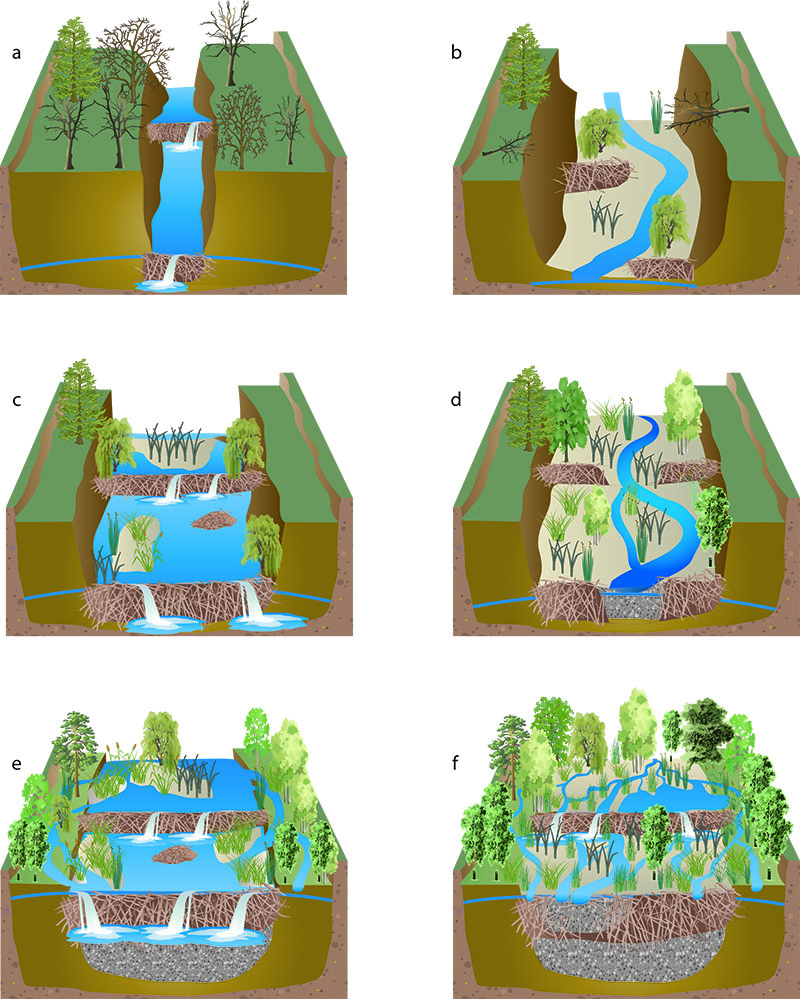
These illustrations all come from observation. We observed that beaver were building dams in streams that were downcut, and the dams kept blowing out (a). They would start to recover, but then they’d fail.
When you put in a beaver dam, you reduce the ability of the stream to scour its bed, but you do not reduce its ability to erode its bank, so there is lateral erosion. With that lateral erosion, over time, the narrow trench becomes wider. Then, when the beaver build, there is a little aggradation and a little more vegetation, and the beaver create an inset floodplain (b). In that inset floodplain, the dams slow the flow of water, trap more sediment, and allow more deposition to occur. In the process, they raise the water table- that curved, blue line. We found that when a trench widens out to around 50 meters, beaver can build dams that are fairly stable (c).
In the next cycle, there is more sediment to work with and a little bit more complexity (d). Over decades, or even centuries, the beaver slowly raise the system back up. The dams keep trapping sediment, and the vegetation helps hold that sediment. There could really be a back-and-forth arrow between (e) and (f), because the beaver may abandon the area for a while, and then there is downcutting, but they come back, and the cycle continues, yielding a complex mosaic that varies with space and time. The key thing to note in (e) and (f) is how high the water table is compared to where it is in (a). When you have downcutting (a), the water table is below the rooting zone of most of the vegetation, and so much productivity is lost.
This diagram helps us understand the idea behind Beaver Dam Analogues. When you have lateral erosion and the channel widens, the amount of sediment you need to aggrade the incised stream increases. But what if we could reinforce existing beaver dams or build dams in an incised trench in such a way that they accelerated the aggradation rate, didn’t blow out, and reduced the amount of sediment needed from upstream sources to get the system back up? In a BioScience article(Pollock et al., 2014), we made the point that we could accelerate the process such that a recovery that previously took decades or centuries to achieve could be accomplished in a few years.
I understand that beaver restoration efforts are most likely to be successful if approached at the watershed scale, but that the guidance offered in the Beaver Restoration Guidebook can be applied at a site-specific scale. Can you share some examples of sites that are unlikely to be successful for enticing or relocating beaver and explain why?
You need “accommodation space.” You need to have land adjacent to the stream that the beaver can flood. If you don’t have that—whether it is an urban area or a rural area where a rancher just doesn’t want beaver around or a farmer is farming right up to the edge of the stream—you will have problems.
In addition to that accommodation space, there must be many factors to consider. What are the best tools currently available for practitioners to identify and prioritize suitable sites for attracting or releasing beaver?
There have been a number of models developed, but I think the best one to date is the Beaver Restoration Assessment Tool developed by Joe Wheaton at Utah State University.
You devote an entire chapter of the Guidebook to Beaver Dam Analogues, structures that mimic or reinforce beaver dams. For the benefit of readers unfamiliar with BDAs, can you describe the types most commonly used?
Reinforcing an existing beaver dam—finding a dam that is in a good location and helping to make sure it doesn’t get blown out—is a great way to go.
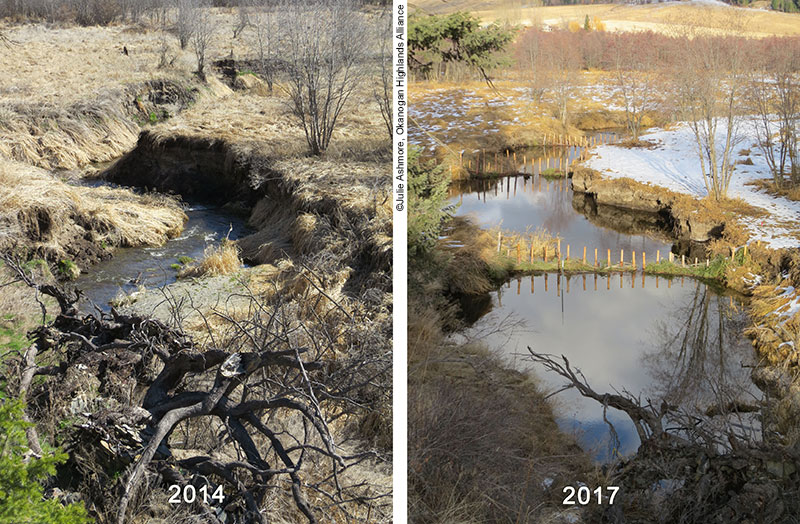
Before (L) and after (R) installing a Beaver Dam Analogue
The most popular BDA is the starter dam, where there is a need to put in something that can hold water right off the bat. Beaver need deep water to protect themselves from predators. Even if you don’t have beaver, raising the water table right away creates the hydrologic conditions for vegetation to grow. The starter dam really helps set the stage for restoration, but building a starter dam is the most labor intensive and expensive BDA option. You can also do a post line with wicker weave, which is a lot less expensive, but only works in places where you have vegetation and a fair amount of sediment moving through the system.
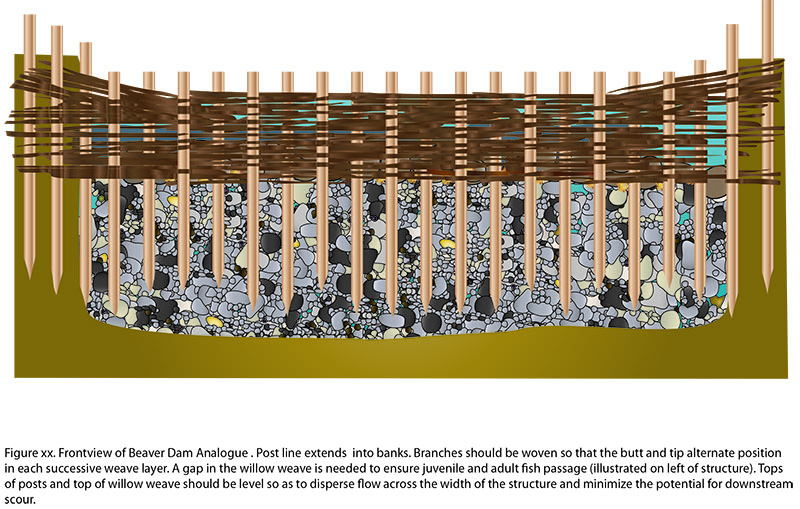
The Guidebook indicates that selecting the right type of BDA is less important than choosing the right location for the structure. Is there a general rule of thumb that universally applies to identifying the right spot for a BDA?
We’ll have a lot of information about that in Version 3.0 of the Guidebook! Beaver almost always put their dams on a riffle crest, so one rule might be to put them on riffle crests. But I have done that and had them fail. A better rule is to find places where beaver have existed before.
Many stream restoration projects in the eastern US involve urban systems. Are BDAs an appropriate restoration tool for incised, flashy, urban streams?
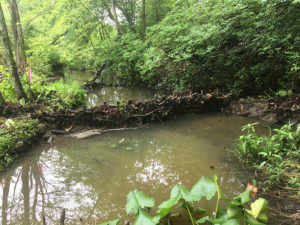
A BDA in an urban area with accommodation space
It really depends on the situation. Whether you have a natural beaver dam or a BDA, you have to have the space. That is the biggest challenge when it comes to using beaver as a restoration tool in urban watershed.
Even in urban places, there are undeveloped areas that are set aside, perhaps because they are wetlands. In a place like Oaks Bottom Wildlife Refuge in the city of Portland, Oregon, for example, there are plenty of places where beaver can build dams.
The nice thing about BDAs is that you can control the elevation better than you can with a beaver dam. You also don’t have the tree cutting that you have with a beaver dam. In an urban setting with the right amount of space, the BDA can be a solution to get some of the wetland and groundwater recharge benefits.
So, BDAs can provide ecological benefits even if beaver do not colonize it?
Yes. We see that frequently. We have BDAs in mine tailings in northern California where there hasn’t been much beaver activity, and we are getting tremendous production in coho salmon.
Generally speaking, what do we currently know about the effectiveness of beaver restoration as a strategy for salmon habitat restoration?
Now you’re right in my wheelhouse. We have top scientists studying that right now. We are finding that it is very effective. We are producing thousands of ESA-listed coho juveniles out of these systems. Most people who study coho salmon understand that slow water habitat is critical. Beaver are providing that. We are finding that the salmon are using beaver ponds in the summer and the winter, and that the ponds are providing a great food resource for them, as well as complex habitat where they can hide from predators. Throughout the year, almost from emergence to when they leave to go out to sea, beaver ponds are providing good habitat that reduces mortality. The number and size of fish leaving beaver ponds is very high relative to the regular stream environment. We hope to have this study out very soon. There have also been studies that have shown good benefits for Atlantic salmon on the East Coast.
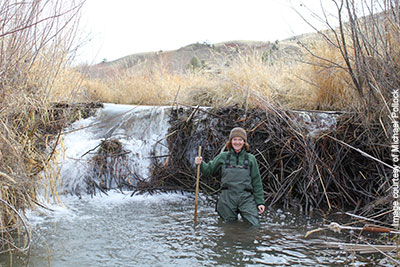
Adult and juvenile steelhead trout were able to pass this 2-meter high dam at Bridge Creek, OR.
People often raise concerns about fish passage. Is that turning out not to be an issue?
It is so not an issue. Fish are jumping right up and over beaver dams. There are natural beaver dams that are two meters high and we know fish were able to get up and over them because we found them in abundance upstream.
Let’s talk about failure. Are there common mistakes practitioners make when installing BDAs that can be avoided?
The biggest mistake is to be afraid of failure. Beaver dams naturally fail, and that is okay. They need maintenance, and they come and go. The dynamic processes of sediment transport and variation in habitat conditions make biologically diverse ecosystems. We don’t want BDAs to never fail.
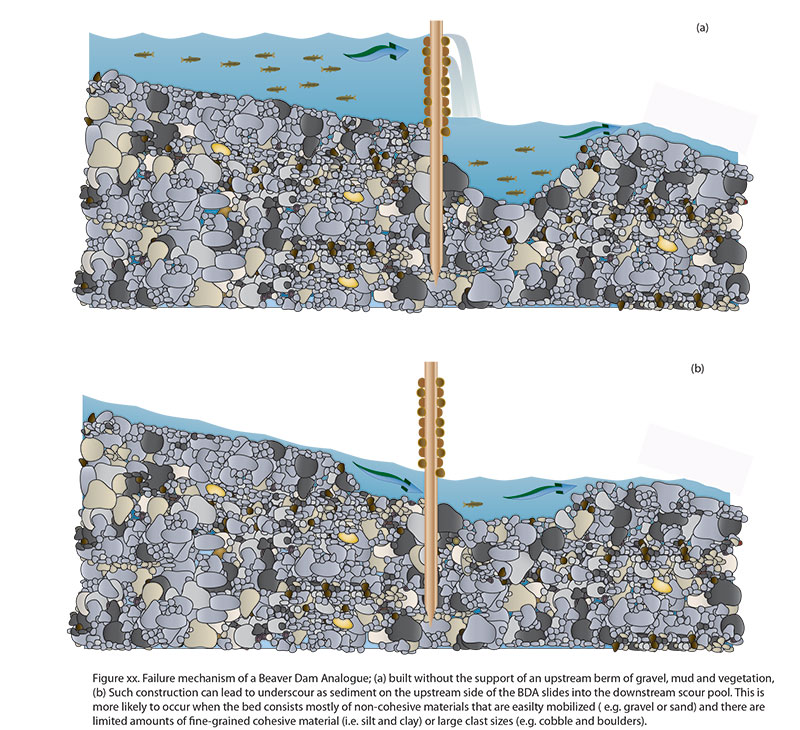
The second most common mistake is not inserting the posts deep enough. Usually, that is because the right equipment wasn’t used to install them. I started out wanting to apply a light touch and use a hand-held post driver. But I have come to believe, from a number of perspectives that include worker safety, that it is much better to get some heavy equipment and use hydraulics to push the posts down.
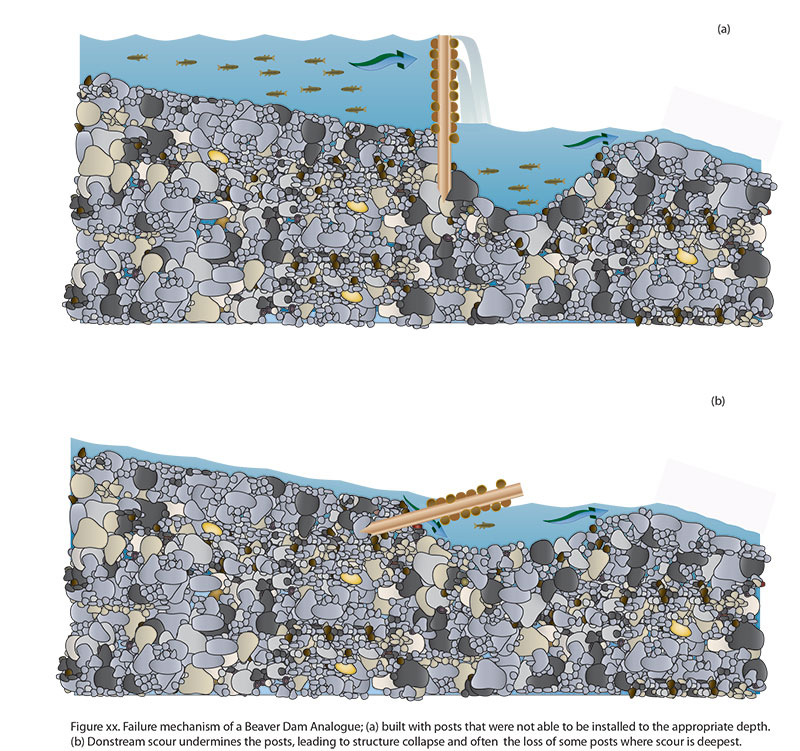
Is there a standard depth?
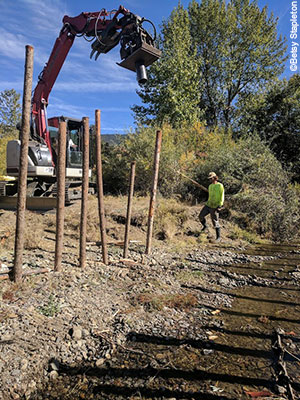 We developed a Beaver Dam Analogue Design Tool, which should be released very soon. It will also be included in Version 3.0 of the Guidebook. The tool gives you the engineering means to calculate how deep the posts need to go.
We developed a Beaver Dam Analogue Design Tool, which should be released very soon. It will also be included in Version 3.0 of the Guidebook. The tool gives you the engineering means to calculate how deep the posts need to go.
The Guidebook points out that failure is normal in beaver relocation projects, and that success rates generally do not exceed 50%. Failure often yields the most powerful lessons. Have you experienced any spectacular failures that have taught you a great lesson when it comes to using beaver as a strategy for ecological restoration?
There have been a few spectacular failures! One that taught me a lot was when we put a post line with wicker weave into a sand-bedded river and did not do any calculations to determine how deep to insert the posts. I thought, “We’ll put the posts down six feet. That’ll be enough.” We did that, and that thing was gone in the first storm—and it wasn’t even a major storm! I learned that you really need to do the calculations and understand bed mobility. Highly mobile beds might not be the best place for BDAs.
Another example is the time I built a BDA that was about four feet tall, which is outside the design guidelines. I knew I was pushing it, but I wanted to get the flow up onto a terrace that used to be a floodplain. I knew if I could just get the water up over four feet, it would disperse the flow and the system would be stable. We did it, and it worked! We were super excited. The BDA trapped a whole bunch of sediment, but we also created this amazing plunge pool below that was about chest deep and kept getting deeper. So we had a deep scour pool and we were already up pretty high, and then, the beaver took over the dam built it even higher. A couple of years later, we had a storm and the whole thing just blew. A huge amount of sediment was released, but an interesting thing happened. We had a series of dams below, where we had been trying and failing for two or three years to aggrade an incision trench. Suddenly, this big slug of sediment came and hit those dams and filled them right up. We had a spectacular failure, but we also instantaneously restored the downstream reach. To quote Bob Dylan in the song Love Minus Zero, “there is no success like failure.”
I was surprised to read that an analysis of depredation permits in California cited chewing (of crops, landscaping, etc.) rather than flooding, as the most commonly reported problem with beaver. Stream restoration projects typically involve a lot of revegetation. What is the best way to ensure that your revegetation efforts don’t end up as a smorgasbord for beaver?
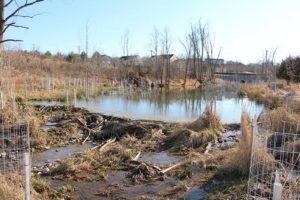
Protected vegetation at a restoration site with beaver
First, you can plant species they don’t like. Second, you can put fencing around each trunk. If you plant at a high enough density and you plant a diversity of species, that tends to reduce it. You can also pick species that can re-sprout. Certain species of willow can handle the cutting by beaver. Beaver cut them down and they grow from the stump. [Editor’s note: The company Beaver Solutions LLC provides a number of useful pointers on protecting trees from beaver chewing.]
What is the best resource for people who want to learn more about beaver restoration and network with people at the forefront of this practice?
The Beaver Restoration Guidebook is intended to be a resource for people who want to learn more. We (NOAA) also host workshops, and we hope to be able to bring some of them to the Midwest and East Coast if we can get the resources to do so. There is a colorful cast of characters associated with beaver, for whatever reason, and the State of the Beaver Conference tends to bring out the best of them. That is always enjoyable. Beaver advocate Heidi Perryman in Martinez, CA has posted a lot of information about urban beaver on the web site Worth A Dam.
Do beaver hold promise for ecological restoration and climate change adaptation in ecosystems other than streams, rivers, and wetlands?
My first thought is “of course not!” But the people are learning that even upland species, like the greater sage grouse (Centrocercus urophasianus), are responding well to beaver habitat. [Editor’s note: see the Sage Grouse Initiative] Indirectly, beaver dams are potentially providing food resources or protective corridors.
Any final words for Leaf Litter readers?
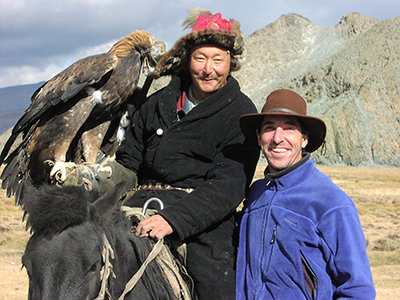
OLYMPUS DIGITAL CAMERA
I’d like to share a story about cultural challenges and the importance of communication. I travelled to the outback of western Mongolia to visit sites where beaver had been reintroduced years ago. I did not find a single beaver. We would ask people around the site about beaver and no one knew what we were talking about. We’d describe “the animal with a big tail” and people would say, “Oh, do you mean muskrat?” When we arrived at the last site on our trip, we met a man named Tarkan. We asked him about beaver and he said, “Oh yeah, those are really good! They have much better fur than the muskrat. There are no more left. Can you get the government to bring more?” Culturally, they wanted the beaver as a resource. Nobody was out there educating these people about the ecological importance of the beaver and informing them that if they left the beaver alone long enough, they would reproduce, and there would be plenty of them.

